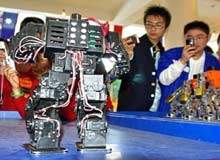
The buzzword in the defence community seems to be ‘asymmetry’ these days, particularly with respect to China’s military build-up. However, asymmetric warfare is not new. More importantly, the asymmetry paradigm does not fully capture the full scope of China’s strategic expansion; for this purpose, better terms would be ‘unrestricted’ or even ‘total warfare’ (with all of its Second World War connotations). If that’s too bloody, let’s try out this one: ‘seamless war’.
Current asymmetric warfare is broadly consistent but by no means universally identical. Many Western observers construe asymmetry as opposing an opponent’s weapons and forces with qualitatively
different weapons and forces of one’s own.
For example, the current edition of the Pentagon’s official yearly report to Congress on China (‘Military Power of the People’s Republic of China, 2008’) describes the Chinese Navy’s submarine build-up as a prime example of China’s approach to asymmetric warfare insofar as they are meant to neutralise US Navy carriers.
In the army space, the report characterises as asymmetric the People’s Liberation Army’s (PLAs) conventional IRBM expansion, which is designed to trump traditional long-range fire support resources with weapons that have even greater range and shorter time to target.
(A)SYMMETRIC WARFARE
See Also:
Even in a purely technological sense, however, asymmetric warfare is a time-honoured tradition. Indeed, the German U-boat campaigns in both world wars served as the foundation for current submarine doctrine, and going even further back in time on land, English longbowmen won at Agincourt by employing asymmetric warfare against the cumbersome French men-at-arms. Most wars of colonisation by Europe’s imperial powers were highly asymmetric from a weaponry standpoint.
How well do you really know your competitors?
Access the most comprehensive Company Profiles on the market, powered by GlobalData. Save hours of research. Gain competitive edge.

Thank you!
Your download email will arrive shortly
Not ready to buy yet? Download a free sample
We are confident about the unique quality of our Company Profiles. However, we want you to make the most beneficial decision for your business, so we offer a free sample that you can download by submitting the below form
By GlobalDataOf course, symmetric warfare is an even older and far more frequent tradition. Although aesthetically pleasing in design, matching like against like in a slugfest is not so elegant on the battlefield – just consider trench warfare in France during the First World War. No wonder that asymmetric warfare is attractive, even to China with its population base.
To the extent that local force imbalances can be created by battlefield manoeuvre, asymmetric warfare is quite ancient. At Cannae in 216BC, Hannibal kick-started his double envelopment plan by concentrating the bulk of his cavalry on his left flank against a Roman cavalry force that was smaller because it was equally divided between the flanks.
Two thousand years later, Napoleon created asymmetric battlefields by massing his artillery to punch holes in tightly packed enemy infantry units, destroying in the process the small artillery forces that opposing commanders doled out along their lines. The German blitzkrieg theorists updated this concept on a theatre-wide scale in 1940 when the Wehrmacht invaded France, which forgot the lessons of its most famous general.
Although asymmetry can be created at times, it is forced upon adversaries at other times. According to Thucydides, the Peloponnesian War at the highest strategic level was an asymmetric match between the great sea power of the Athenian Empire and the famous armies of Sparta (along with its allies). Similarly, the vast majority of guerrilla wars are asymmetric by definition, pitting lightly armed insurgents against regular troops with vastly superior firepower.
In short, warfare is all about asymmetry – even those who seek symmetric battles do so because they have superior strength. When lives are at stake, nobody likes a fair fight.
SEAMLESS WAR
If asymmetry in warfare is the creation of imbalance at one level, seamless war is the conduct of war at many levels. Here, war in its broadest sense is aggressive action aimed at compelling an adversary to yield to your will. As Clausewitz famously stated, ‘war is the continuation of politics by other means’.
In the current Chinese interpretation, ‘other means’ apparently encompasses every instrument in the toolkit.
According to the Pentagon’s 2008 China report, internal debates among Chinese strategists ‘highlight China’s interest in non-kinetic means of warfare and the increased role of economic, financial, information, legal, and psychological instruments in PLA theory and war planning’.
The report takes pains to let Chinese doctrine speak for itself: Underscoring a comprehensive, multidimensional view of warfare, the PLA Academy of Military Science text, the Science of Military Strategy, notes that ‘war is not only a military struggle, but also a comprehensive contest on fronts of politics, economy, diplomacy and law’.
China has formally institutionalised this paradigm in state policy to at least some degree. The Pentagon report notes that in 2003, the top political and military executive committees approved the concept of ‘Three Warfares’ (san zhong zhanfa), highlighting the relevance of non-kinetic options (i.e. not physically violent options) as a guiding strategic precept.
- Psychological warfare: the use of propaganda, deception, threats, and coercion to degrade the enemy’s ability to comprehend the objective situation and to make appropriate, effective decisions.
- Media warfare: the dissemination of information to sway public opinion and obtain support from domestic and foreign audiences for China’s military actions.
- Legal warfare: the use of international and domestic laws and legal systems (e.g. the United Nations) to gain international support for and manage possible political repercussions of China’s military actions.
Even from the narrow perspective of army technology, some key implications emerge:
- There is no such thing as purely peaceful technology. Given that warfare is multidimensional and all encompassing, all technologies are potential dual-use assets.
- Grey areas between different dimensions of war (e.g. between economic or industrial and purely military) are not just fair game, but actually preferred niches of operation to the extent that the institutional structures or philosophic cultures prevent them from operating effectively in these areas. From this perspective, cyberwarfare is nothing more than an extension of clandestine paramilitary operations to a new technological level.
- Because dimensions of warfare are intrinsically connected, truly integrated strategy should enable ‘non-kinetic options’ to create organic asymmetries in the purely military sphere.
Finally, strategic deception is a key catalyst of asymmetry in every dimension.
To quote the Pentagon report, “PLA doctrinal writings point to a working definition of strategic deception as ‘[luring] the other side into developing misperceptions, and [establishing for oneself] a strategically advantageous position by producing various kinds of false phenomena in an organised and planned manner with the smallest cost in manpower and materials’.”
Consistent with a theoretical tradition that dates back to Sun Zi (the Pinyin spelling / pronunciation of Sun Tzu), deception runs the gamut from conventional camouflage to information warfare operations.






